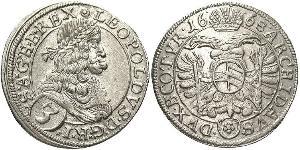(Vendue pour $29.0)
1995, Spain (Republic). Large Proof Silver 5 Ecu "Don John of Austria" Coin. R!
Mint Years: 1995
Mint Place: Madrid
Denomination: 5 Ecu
References: KM-XMA17 ($75!).
Condition: Proof in original plastic capsule!
Weight: 33.6gm (0.9998 Oz. Pure Silver!)
Material: Sterling Silver (925)
Diameter: 42mm
The European Currency Unit (₠ or ECU) was a basket of the currencies of the European Community member states, used as the unit of account of the European Community before being replaced by the euro on 1 January 1999, at parity. The ECU itself replaced the European Unit of Account, also at parity, on 13 March 1979. The European Exchange Rate Mechanism attempted to minimize fluctuations between member state currencies and the ECU. The ECU was also used in some international financial transactions, where its advantage was that securities denominated in ECUs provided investors with the opportunity for foreign diversification without reliance on the currency of a single country.
The ECU was conceived on 13 March 1979 as an internal accounting unit. It had the ISO 4217 currency code XEU.
On 1 January 1999, the euro (with the code EUR and symbol €) replaced the ECU, at the value €1 = 1 ECU. Unlike the ECU, the euro is a real currency, although not all member states participate (for details on euro membership see Eurozone). Two of the countries in the ECU basket of currencies, UK and Denmark, did not join the eurozone, and a third, Greece, joined late. On the other hand, Finland and Austria joined the Eurozone from the beginning although their currencies were not part of the ECU basket (since they had joined the EU in 1995, two years after the ECU composition was "frozen").
Due to the ECU being used in some international financial transactions, there was a concern that foreign courts might not recognize the euro as the legal successor to the ECU. This was unlikely to be a problem, since it is a generally accepted principle of private international law that states determine their currencies, and that therefore states would accept the European Union legislation to that effect. However, for abundant caution, several foreign jurisdictions adopted legislation to ensure a smooth transition. Of particular importance, the USA states of Illinois and New York adopted legislation to ensure a large proportion of international financial contracts recognized the euro as the successor of the ECU.
John of Austria (24 February 1547 – 1 October 1578), in English traditionally known as Don John of Austria, in Spanish as Don Juan de Austria and in German as Ritter Johann von Österreich, was an illegitimate son of Holy Roman Emperor Charles V. He became a military leader in the service of his half-brother, Philip of Spain and is best known for his naval victory at the Battle of Lepanto in 1571 against the Ottoman Empire.
3 Kreuzer Ååstenrik Argent Léopold Ier de Habsbourg(1640-1705)
Le groupe a 10 pièces / 7 prix
⇑
























